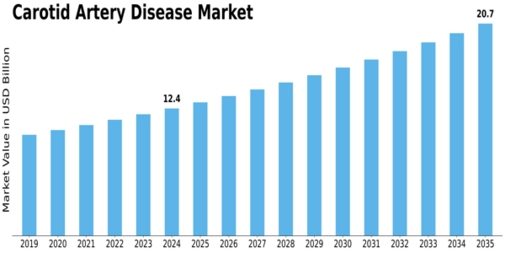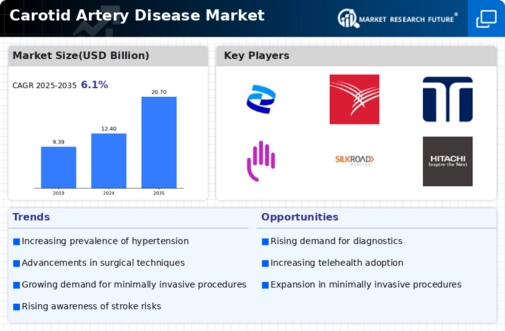Carotid Artery Disease Size
Carotid Artery Disease Market Growth Projections and Opportunities
The carotid artery disease treatment market is a crucial component of healthcare, focusing on addressing blockages or narrowing in the carotid arteries, which can lead to serious complications such as strokes and transient ischemic attacks (TIAs). Carotid artery disease occurs when the arteries in the neck that supply blood to the brain become narrowed or blocked by a buildup of plaque, a condition known as carotid artery stenosis. This market segment encompasses a range of treatment modalities aimed at reducing the risk of stroke and improving blood flow to the brain.
One of the primary treatment options for carotid artery disease is lifestyle modifications and risk factor management. Patients are often advised to adopt a healthy lifestyle, including smoking cessation, regular exercise, a balanced diet low in saturated fats and cholesterol, and maintaining a healthy weight. Controlling underlying risk factors such as hypertension, diabetes, and hyperlipidemia is also essential in preventing the progression of carotid artery disease and reducing the risk of stroke.
In addition to lifestyle modifications, pharmacological interventions play a crucial role in the management of carotid artery disease. Medications such as antiplatelet agents (e.g., aspirin, clopidogrel), statins, antihypertensive drugs, and anticoagulants may be prescribed to reduce the risk of blood clots, lower cholesterol levels, control blood pressure, and prevent further plaque buildup in the arteries. These medications are often used in combination with lifestyle modifications to optimize cardiovascular health and reduce the risk of stroke.
For patients with severe carotid artery stenosis or those at high risk of stroke, invasive procedures such as carotid endarterectomy (CEA) and carotid artery stenting (CAS) may be recommended. Carotid endarterectomy involves surgically removing the plaque from the inner lining of the carotid artery to restore blood flow to the brain. This procedure is typically performed under general anesthesia and requires a short hospital stay. Carotid artery stenting, on the other hand, involves inserting a stent (a small mesh tube) into the narrowed artery to hold it open and improve blood flow. This minimally invasive procedure is performed using a catheter-based approach and is often preferred for patients who are not candidates for surgery or who have high-risk anatomical features.
The carotid artery disease treatment market is influenced by various factors, including demographic trends, advancements in medical technology, healthcare policies, and reimbursement landscape. With an aging population and a growing prevalence of cardiovascular risk factors such as hypertension, diabetes, and obesity, the incidence of carotid artery disease is expected to rise globally. This trend underscores the importance of early detection, comprehensive risk assessment, and timely intervention to prevent stroke and improve patient outcomes.
Technological advancements are driving innovation in the diagnosis and treatment of carotid artery disease, with emerging trends such as high-resolution imaging, artificial intelligence (AI), and minimally invasive techniques showing promise in enhancing patient care. High-resolution imaging modalities such as ultrasound, magnetic resonance angiography (MRA), and computed tomography angiography (CTA) enable healthcare providers to visualize the extent of carotid artery stenosis and assess the risk of stroke with greater precision. AI algorithms are being developed to analyze medical imaging data and assist clinicians in identifying high-risk plaque features, guiding treatment decisions, and predicting patient outcomes.










Leave a Comment